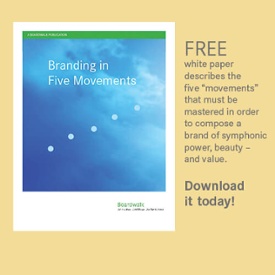 There’s so much confusion these days about what’s called the purpose-driven brand. Regular readers of Brandtalk know I’ve complained in the past about how people muddy the waters by assigning different meanings to “brand purpose”. It’s frustrating because many in the business community are already skeptical about branding. Some still think of it as touchy-feely, unmeasurable hogwash. It’s often dismissed as just another buzzword. And part of the reason these misconceptions are so hard to dispel is those of us in the branding community are already confusing people by using different jargon to mean different things. Business people are to be forgiven their skepticism when two different branding “experts” address the same branding problem sounding nothing like each other. We come off as kooks. Now we’re muddying the waters further by each having our own definition of brand purpose. I’d like to propose we, the branding community, attempt to clear this up by standardizing our terminology. I suggest we adopt “brand purpose” to mean the purpose to which a market puts a brand. I propose “social purpose” as the way a brand makes its customers’ lives better. Finally, let’s go with “cause marketing” as the leverage of social issues for commercial purposes. If we could adopt those terms, or some just like them, we’d finally be able to stop talking past each other. And our clients would find clarity.
There’s so much confusion these days about what’s called the purpose-driven brand. Regular readers of Brandtalk know I’ve complained in the past about how people muddy the waters by assigning different meanings to “brand purpose”. It’s frustrating because many in the business community are already skeptical about branding. Some still think of it as touchy-feely, unmeasurable hogwash. It’s often dismissed as just another buzzword. And part of the reason these misconceptions are so hard to dispel is those of us in the branding community are already confusing people by using different jargon to mean different things. Business people are to be forgiven their skepticism when two different branding “experts” address the same branding problem sounding nothing like each other. We come off as kooks. Now we’re muddying the waters further by each having our own definition of brand purpose. I’d like to propose we, the branding community, attempt to clear this up by standardizing our terminology. I suggest we adopt “brand purpose” to mean the purpose to which a market puts a brand. I propose “social purpose” as the way a brand makes its customers’ lives better. Finally, let’s go with “cause marketing” as the leverage of social issues for commercial purposes. If we could adopt those terms, or some just like them, we’d finally be able to stop talking past each other. And our clients would find clarity.
I didn’t invent the above definitions although I’ve always used “brand purpose” in this way. But there was a terrific article in Fast Company by Aytekin Tank, founder of JotForm, where he, thankfully, outlined the distinction. And I suppose that, because brands are always innovating and growing, there are always going to be these periods of confusion before everybody settles on common terminology and moves on. But let’s take a closer look at Mr. Tank’s definitions.
Brand Purpose
What is the purpose of a hammer? It could be to drive a nail. It could be to pull a nail. It could be to smash open a coconut. The point is the hammer doesn’t get to define its purpose. Lying inert on a workbench, the hammer has no purpose. It is only when someone picks up the hammer – with intent – that the tool gains a purpose. It is the user of the tool that gives the tool its purpose.
So it is with brands. People use the products and services of businesses to achieve some sort of aim, some purpose in their life. Businesses usually have no idea what their clients’ or customers’ true purpose is. If four guys wanted to buy Teslas, nobody at Tesla would know the reasons why. Maybe one’s a car enthusiast and always has to have the coolest ride. Maybe one wants to do his bit to fight climate change. Maybe one’s cheap and wants the good gas mileage. Maybe one intends to impress girls. Tesla does not get to decide for itself what its purpose is to these four guys.
The only way a brand can determine its purpose is to do some deep research. FedEx did it. If those same four guys all wanted to send packages via FedEx, presumably they each would have different purposes for doing so. Or would they? Digging deeper into their own research findings, FedEx learned that there was a common denominator that all their customers wanted – peace of mind. So FedEx is really not about sending packages at all. Any courier service can do that. People come to FedEx because they want the certainty that their packages will “absolutely, positively” be there overnight. The FedEx brand’s purpose statement is: “FedEx exists to bring peace of mind to everyday interactions.” Note that the purpose statement is written from their customers’ point of view.
How is innovation influencing your brand?
Let Boardwalk harness it for you.
Social Purpose
These days, when people refer to the purpose-driven brand, they’re almost always talking about what Tank calls (and I’m with him) social purpose. The most pure and well-known example of a business pursuing a social purpose is, of course, Yvon Chouinard and Patagonia. Patagonia isn’t a company that was started by an avid rock climber. Patagonia was a necessity. It had to be founded because that was the only way Chouinard could support his nomadic, rock-climbing obsession. In order to spend most of the year climbing full-time, he spent his winters forging iron pitons and selling them to other climbers. But after a while his pitons were everywhere, scarring every popular rock-climbing site in the country. His success was not only supporting his lifestyle. It was destroying what he most enjoyed about it, a life outdoors in pristine, natural surroundings. In 1972, he replaced the pitons in his catalog with reusable aluminum chocks that didn’t have to be hammered into rock crevices, damaging them in the process. It was a huge risk to discontinue his most popular product. But it was in that catalog, where he introduced the reusable chocks, where he first opined about the importance of preserving our planet. Business boomed.
It’s important to note that Patagonia was launched as a part-time gig to support Chouinard’s vagabond, rock-climbing lifestyle. That’s what gives Patagonia standing to speak out on environmental issues. If IBM were to suddenly start advocating for saving the planet, I don’t think many would complain. But its voice wouldn’t carry as much weight. As far as most of us know, there is nothing in IBM’s background to let us believe it has any authority on the matter. Given the nature of Patagonia’s business, it just makes sense for them to champion this cause.
And that’s the key to social purpose. Any business that is considering promoting its social purpose must ask itself: Who are we to start preaching about this issue? What standing do we have? What do we know about the subject? Are we willing to stick with this long-term? Because this will be a permanent part of our brand promise, not a temporal campaign. Most importantly, what are we willing to risk to go down this path? If nothing, then find another social purpose.
That brings us to …
Cause marketing
I have to choose my words carefully here. I’ve never seen a narwhal but that doesn’t mean they don’t exist. Likewise, I can’t think of an example of cause marketing that isn’t cynical and exploitative. But that doesn’t mean it hasn’t been done, or that it could never be done. Cause marketing, in this definition, is piggybacking off a popular cause for commercial purposes. And the classic example here is the ad featuring Kendall Jenner that Pepsi ran and had to quickly pull off the air. It’s been written about extensively, including by me. So if you don’t know the story, it will be easy to find. Suffice it to say it was harshly received because it was perceived to be a crass, commercial exploitation of social protest movements, particularly, the Black Lives Matter movement. Pepsi has no experience with these sorts of movements. It has no standing to make any sort of commentary. It risked nothing with its tepid endorsement of protest as a “lifestyle”. It was sad and pathetic. Kids! Don’t do what Pepsi did.
So these are my definitions, as inspired by Aytekin Tank. I’m open to hearing other points of view, other definitions, or refinements of these ones. And, if anyone knows a successful, non-exploitative, example of cause marketing, as defined above, I’d love to hear about it. I’ve always wanted to see a narwhal. Innovation is a big part of branding so I never say never.
Best Branding Reads – Week of July 1, 2019
As an LGBTQ+ ally, P&G is navigating the complexities of operating in anti-gay markets
Here’s the right way to be profitable while standing up to pushback on your social purpose.
How Simplicity Drives Brand Loyalty
It’s a complex business, getting to simplicity. But it’s absolutely worth it.
Megan Rapinoe’s new lifestyle brand is built on inclusive design
Interesting brand identity based around one simple act of rebellion: a backwards “e”.
7 Types Of Frictionless Retail
Again. Retail is not dying. It’s evolving into something new, perhaps, something spectacular.
IKEA creates own font
Actually, IKEA did not create the font. Their customers did, in a perfect example of the market exerting control over the brand.
Pizza Hut resurrects its classic logo because it’s awesome
Let’s face it. Pizza Hut’s visual identity is a mess. Using the old logo part of the time just make it messier.
Unilever & Patagonia are building a brand on purpose while Wayfair goes wayward
On the other hand, if no one sells beds to the government, the kids will still be sleeping on the floor. Maybe they should donate the beds?



